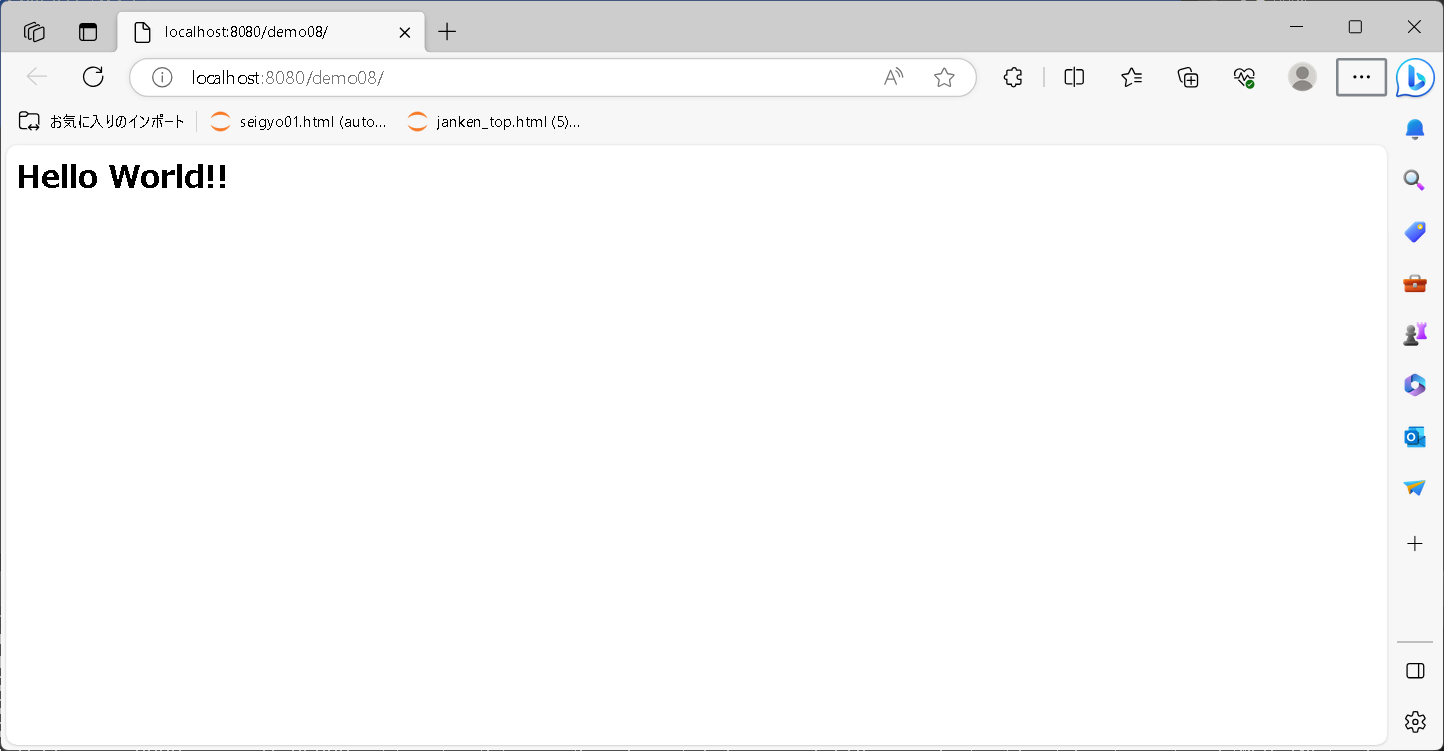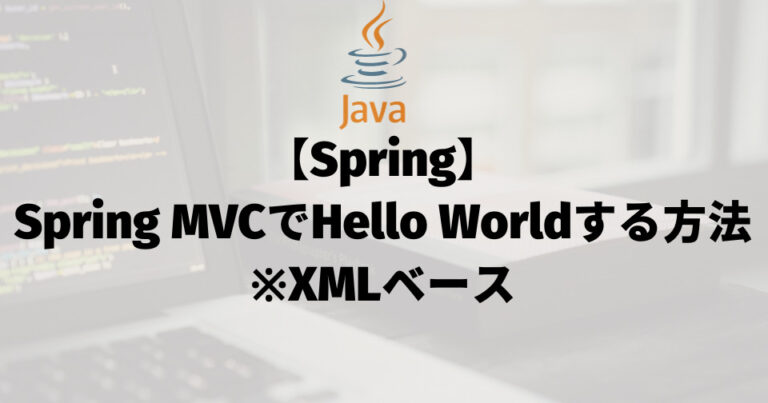概要
Springを学びなおすにあたり、Spring MVCでHello Worldしたのでその基本的な方法についてまとめた。
前回はBean定義ファイルをJavaのアノテーションベースで作成したが、今回はXMLベースで作成する。
概要 Springを学びなおすにあたり、Spring MVCでHello Worldしたのでその方法についてまとめた。 今回はアノテーションベースのBean定義方法で実装した。 Spring MVCの特徴 Spr[…]
ファイル構成
今回作成するファイルの全体像は以下となる。
ファイル詳細
demo08
│
└─src
└─main
├─java
│ └─com
│ └─example
│ └─app
│ └─WelcomeController.java
│
├─resources
│ ├─message.properties
│ │
│ └─META-INF
│ ├─app-webContext.xml
│ └─applicationContext-08.xml
│
└─webapp
└─WEB-INF
├─index.jsp
└─web.xml
DIコンテナの準備
Spring MVCで実装をすすめるために、ルートアプリケーションコンテキストとWEBアプリケーションコンテキストのDIコンテナを用意する。
ルートアプリケーションコンテキスト
サービス層以下(Service、Repository、DataSourceなど)のBeanを管理するDIコンテナ。
サーブレットコンテナ起動時、ContextLoaderListenerによってルートアプリケーションコンテキストが作成される。
ルートアプリケーションコンテキスト作成時、Bean定義ファイルを読み込んで初期化する。
ルートアプリケーションコンテキストが管理しているBeanは、アプリケーション全体で参照可能になる。
JavaアノテーションベースでHello Worldした際には、AppConfig.javaをBean定義ファイルとしていた。
今回はクラスパス上にMETA-INFフォルダを作成し、Bean定義ファイル(XML)を格納する。
Bean定義ファイル
ルートアプリケーションコンテキストが参照するBean定義ファイルを作成する。
applicationContext-08.xml
<?xml version="1.0" encoding="UTF-8"?>
<beans xmlns="http://www.springframework.org/schema/beans"
xmlns:xsi="http://www.w3.org/2001/XMLSchema-instance"
xsi:schemaLocation="
http://www.springframework.org/schema/beans
http://www.springframework.org/schema/beans/spring-beans.xsd
">
<!-- ① -->
<bean id="messageSource"
class="org.springframework.context.support.ResourceBundleMessageSource">
<property name="basename" value="message" />
</bean>
</beans>
上記はResourceBundleMessageSourceをBean定義している。
ResourceBundleMessageSourceはSpringフレームワークが提供しているクラスでメッセージリソース(プロパティファイル)を扱う。
今回はクラスパス上に作成したmessage.propertiesを参照するように設定している。
message.properties
welcome.message=Hello World!!
プロパティファイルの文字コードは「ISO-8859-1」で定義している。
サーブレットコンテナ登録
作成したBean定義ファイルをルートアプリケーションコンテキストに管理させるために、web.xmlにContextLoaderListenerを定義する。
ContextLoaderListenerはサーブレット起動時にルートアプリケーションコンテキスト(DIコンテナ)を作成するリスナクラス。
Bean定義ファイルを指定することで、ルートアプリケーションコンテキストに管理させたいBeanの初期化を行うことができる。
尚、Bean定義ファイルの場所指定がない場合、デフォルトで「/WEB-INF/applicationContext.xml」を参照する。
web.xml
<listener>
<listener-class>
org.springframework.web.context.ContextLoaderListener
</listener-class>
</listener>
<context-param>
<param-name>contextConfigLocation</param-name>
<param-value>classpath:/META-INF/applicationContext-08.xml</param-value>
</context-param>
<param-value>タグを使用してBean定義ファイルを指定する。
Webアプリケーションコンテキスト
WEB層のBean(主にController)を管理するDIコンテナ。
DispatcherServlet初期化時に、一緒にWebアプリケーションコンテキストが初期化されてBean定義ファイルを読み込む。
※Service層以下のコンボーネントは、Webアプリケーションコンテキストが管理しているBeanを参照できない
Bean定義ファイル作成
Webアプリケーションコンテキストが参照するBean定義ファイルを作成する。
app-webContext.xml
<?xml version="1.0" encoding="UTF-8"?>
<beans xmlns="http://www.springframework.org/schema/beans"
xmlns:xsi="http://www.w3.org/2001/XMLSchema-instance"
xmlns:mvc="http://www.springframework.org/schema/mvc"
xmlns:context="http://www.springframework.org/schema/context"
xsi:schemaLocation="http://www.springframework.org/schema/beans
http://www.springframework.org/schema/beans/spring-beans.xsd
http://www.springframework.org/schema/mvc
http://www.springframework.org/schema/mvc/spring-mvc.xsd
http://www.springframework.org/schema/context
http://www.springframework.org/schema/context/spring-context.xsd
">
<!-- ① -->
<mvc:annotation-driven />
<!-- ② -->
<context:component-scan base-package="com.example.app" />
<!-- ③ -->
<mvc:view-resolvers>
<mvc:jsp/>
</mvc:view-resolvers>
</beans>
<mvc:annotation-driven />Spring MVCのアノテーションを有効にする設定。
上記により、@Controllerなどのアノテーションが機能したり@RequestMappingをつけたメソッドとURLをルーティングできたりする。
コントローラーを格納しているパッケージ内にて、@Controllerや@Conponentアノテーションがついたクラスを自動で検索してBean管理する。
<mvc:view-resolvers> <mvc:jsp/></mvc:view-resolvers>Viewリゾルバーの設定。
Controllerから返却される文字列をもとに、WEB-INF配下のjspファイルと紐づける。
指定したフォルダ配下のjspを参照させる設定等もできる。
サーブレットコンテナ登録
作成したBean定義ファイルをWebアプリケーションコンテキストに管理させるために、web.xmlにDispatcherServletを定義する。
DispatcherServletは初期化されるタイミングでWebアプリケーションコンテキストを作成する。
※DispatcherServletにWebアプリケーションコンテキスト(DIコンテナ)がぶら下がっているイメージ
DispatcherServlet初期化時にBean定義ファイルを指定することで、Webアプリケーションコンテキストに管理させたいBeanの初期化を行うことができる。
尚、Bean定義ファイルの場所指定がない場合、デフォルトでWEB-INF/[servlet-name]-servlet.xmlを参照する。
web.xml
<servlet>
<servlet-name>app</servlet-name>
<servlet-class>org.springframework.web.servlet.DispatcherServlet
</servlet-class>
<init-param>
<param-name>contextConfigLocation</param-name>
<param-value>classpath:/META-INF/app-webContext.xml</param-value>
</init-param>
<load-on-startup>1</load-on-startup>
</servlet>
<servlet-mapping>
<servlet-name>app</servlet-name>
<url-pattern>/</url-pattern>
</servlet-mapping>
<param-value>を指定してBean定義ファイルを指定する。
Hello World
必要な実装準備が整ったので、Hello Worldを実装する。
Controller
URLとルーティングするためコントローラークラスを作成する。
WelcomeController.java
package com.example.app;
import java.util.Locale;
import org.springframework.beans.factory.annotation.Autowired;
import org.springframework.context.MessageSource;
import org.springframework.stereotype.Controller;
import org.springframework.ui.Model;
import org.springframework.web.bind.annotation.RequestMapping;
@Controller
public class WelcomeController {
@Autowired
private MessageSource messageSource; // ①
@RequestMapping("/")
public String home(Model model) {
// ②
// メッセージプロパティからメッセージ設定
String welcomeMsg = messageSource.getMessage("welcome.message", null, Locale.JAPANESE);
model.addAttribute("msg", welcomeMsg); // ③
return "index";
}
}
@Autowiredprivate MessageSource messageSource;Bean定義したMessageSourceオブジェクトをDIする。
これにより、メッセージプロパティから定義したメッセージを取得できる。
上記の記述をすることで、置換文字列のないメッセージを取得できる。
上記はメッセージプロパティに定義した「welcome.message=Hello World!!」を参照して「Hello World!!」という値を取得している。
model.addAttribute("msg", welcomeMsg);Modelクラスに上記のように記述することで、リクエストスコープに値を格納できる。
index.jsp
<html lang="ja">
<body>
<h2>${msg}</h2>
</html>
EL(Expression Language)式で${msg}と記述することで、メッセージプロパティから取得した「Hello World!!」を画面表示できる。

補足
最終的なweb.xmlは以下となる。
Javaアノテーションベースで作成したHello Worldの記事に下記の設定内容は紹介しているため、ここでは割愛する。
web.xml
<?xml version="1.0" encoding="UTF-8"?>
<web-app xmlns="http://java.sun.com/xml/ns/javaee"
xmlns:xsi="http://www.w3.org/2001/XMLSchema-instance"
xsi:schemaLocation="
http://java.sun.com/xml/ns/javaee
http://java.sun.com/xml/ns/javaee/web-app_3_0.xsd
"
version="3.0">
<listener>
<listener-class>
org.springframework.web.context.ContextLoaderListener
</listener-class>
</listener>
<context-param>
<param-name>contextConfigLocation</param-name>
<param-value>classpath:/META-INF/applicationContext-08.xml</param-value>
</context-param>
<filter>
<filter-name>CharacterEncodingFilter</filter-name>
<filter-class>
org.springframework.web.filter.CharacterEncodingFilter
</filter-class>
<init-param>
<param-name>encoding</param-name>
<param-value>UTF-8</param-value>
</init-param>
<init-param>
<param-name>forceEncoding</param-name>
<param-value>true</param-value>
</init-param>
</filter>
<filter-mapping>
<filter-name>CharacterEncodingFilter</filter-name>
<url-pattern>/*</url-pattern>
</filter-mapping>
<servlet>
<servlet-name>app</servlet-name>
<servlet-class>org.springframework.web.servlet.DispatcherServlet
</servlet-class>
<init-param>
<param-name>contextConfigLocation</param-name>
<param-value>classpath:/META-INF/app-webContext.xml</param-value>
</init-param>
<load-on-startup>1</load-on-startup>
</servlet>
<servlet-mapping>
<servlet-name>app</servlet-name>
<url-pattern>/</url-pattern>
</servlet-mapping>
<jsp-config>
<jsp-property-group>
<url-pattern>*.jsp</url-pattern>
<page-encoding>UTF-8</page-encoding>
<include-prelude>/WEB-INF/include.jsp</include-prelude>
</jsp-property-group>
</jsp-config>
</web-app>

